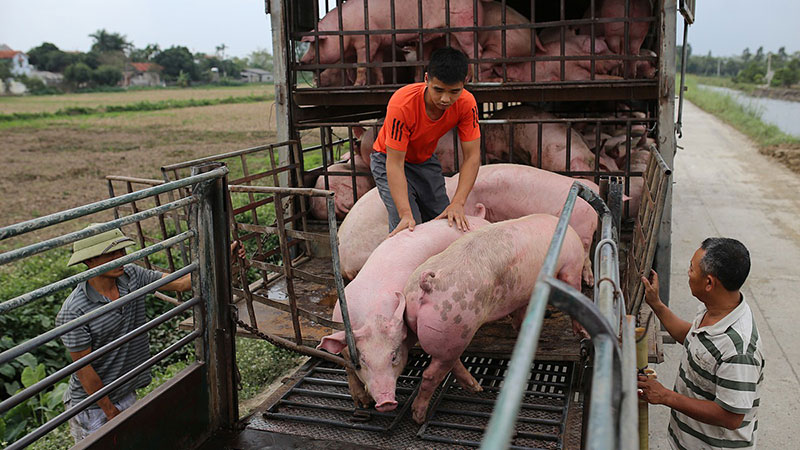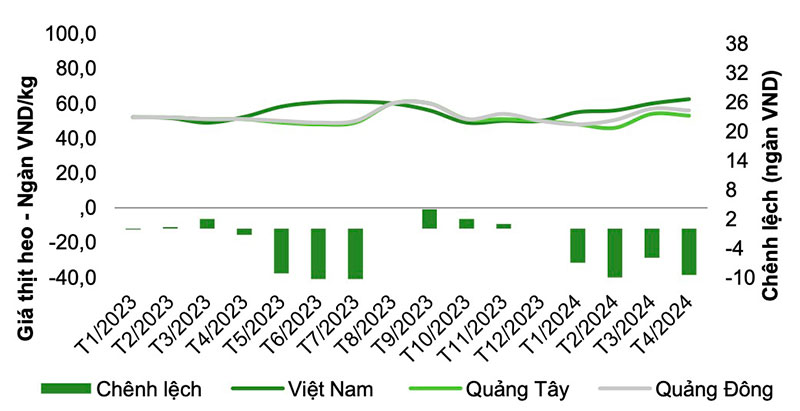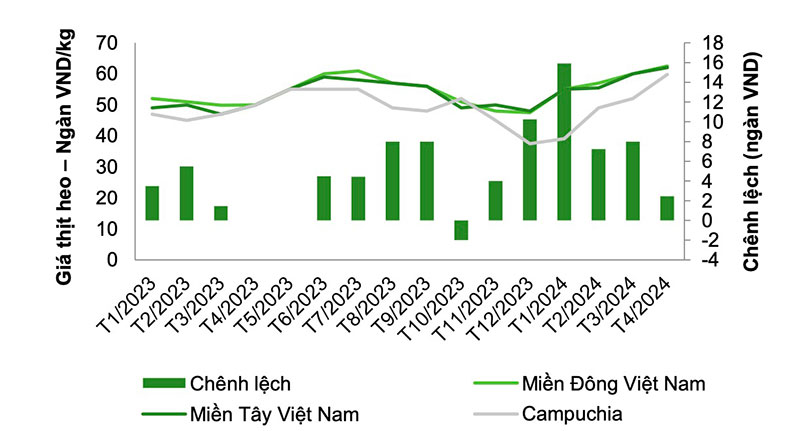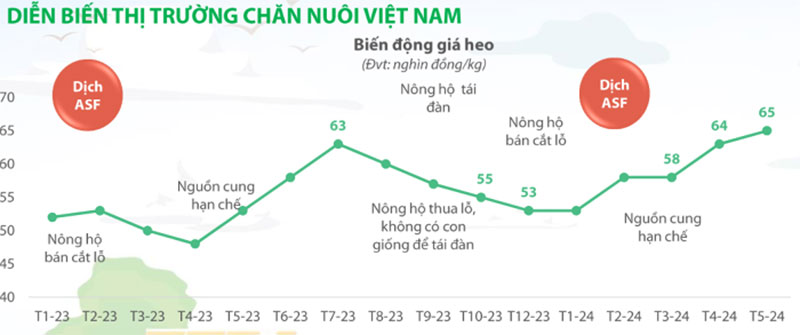According to representatives of large pig farming enterprises, the livestock industry is entering a new cycle with live pig prices expected to remain high until 2025. Currently, live pig prices across the country have reached their highest level since the beginning of 2023 to now.
Shortage of domestic and imported supplies
Since mid-March 2024, hog prices across the country have maintained a positive upward momentum and are currently reaching 65,000 VND per kg in many localities – the highest price since the beginning of 2023 until now, even recording received a price of 68,000 VND per kg in scattered places.
According to the representative of the Vietnam Livestock Association with Industry and Trade Magazine, the increase in pig prices is being supported mainly by the scarcity of pig supply and partly by market psychology.
The price of live pigs in some places this weekend reached 68,000 VND/kg, mainly due to lack of supply.
In the Northern region, the local pig supply is assessed by some industry organizations to not be much left, and the inventory of giant pigs (large-sized pigs) is quite small. Meanwhile, the price level of pigs in all three regions of the country is almost equal, so the flow of pigs from the Central and South to the North is quite weak.
In particular, the difference in pig prices in Northern Vietnam and Chinese localities nearing the border is low, causing the flow of live pigs between the two countries to remain “frozen”.
Correlation of pork prices in the Vietnamese market with the two provinces of Guangxi and Guangdong of China. (Source: Agromonitor, VCBS)
Similarly in the South and Central regions, the local pig supply is low. Specially, the difference in pig price between Vietnam and Thailand in mid-March reached 20,000 VND per kg. With this attractive price, a lot of Thai pigs were imported to Cambodia and are expected to be brought back Vietnam.
However, in April, Thai pigs have not yet been recorded imported into our country. The main reason is that border gates in the Central region tightened quarantine when Thailand recorded an anthrax outbreak in livestock. At the same time, the pork price difference between Vietnam and Thailand has gradually narrowed to only 11 – 15,000 VND per kg, while transportation costs have tended to increase, making most traders no longer find it attractive.
Correlation of pork prices in Vietnam and Cambodia markets. (Source: Agromonitor, VCBS)
According to data from market research firm Agromonitor, the number of pigs from Cambodia to Vietnam also began to gradually decrease since the beginning of April, to around 2,000 pigs per day, as the country entered the traditional Tet holiday. At the same time, the difference in pig prices between Cambodia and Vietnam is low as the price of live pigs in Cambodia is currently around 60,500 – 61,000 VND per kg.
The new pig industry cycle is expected to last 2 years
Notably, current data shows that domestic demand for restocking is decreasing significantly. The total number of pig breeds imported to Vietnam in 2023 will only reach 5,457 pigs, down 31% compared to 2022. In the first quarter of 2024, the amount of pig breeds imported will be quite small, with only 565 pigs remaining, down 82% compared to the same period in 2023.
According to the recent sharing of Mr. Ngo Cao Cuong – Chief Financial Officer of BaF Vietnam Agriculture Joint Stock Company (stock code BAF – HoSE), live pig prices are increasing again mainly due to supply factors. The recent African swine fever (ASF) epidemic has greatly affected the supply of breeding animals, causing large livestock enterprises to import breeding pigs at high costs.
Pig price cycle in the domestic market from early 2023 to present. (Source: BaF Việt Nam)
According to BaF Vietnam’s Chief Financial Officer, the recent ASF outbreak could affect up to 1 million pigs nationwide. Meanwhile, both livestock enterprises and small livestock farmers are in the process of restocking their herds and need to wait until at least December 2024 to have new supply on the market.
With current market developments, the price of live pigs is expected to increase to about 70,000 VND/kg by the end of the second quarter and can be maintained for most of this year, Mr. Ngo Cao Cuong said.
Meanwhile, Mr. Doan Nguyen Duc – Chairman of the Board of Directors of Hoang Anh Gia Lai Group Joint Stock Company (stock code HAG – HoSE exchange) said that the price increase cycle of the pig industry usually takes place in 2 years and the cycle In the immediate future, it is expected to last from 2024 to 2025.
Industrial livestock enterprises such as Hoang Anh Gia Lai expect to “take in” all the profits of the pig segment next year amid the complicated development of the ASF epidemic, with only large enterprises having met safety conditions. Only after an epidemic can we rest assured that we can regroup.
In addition, according to the provisions of the Law on Livestock, from January 1, 2025, livestock facilities in areas where livestock farming is not permitted in cities, towns, townships, and residential areas will be forced to to move. This will cause tens of thousands of livestock farms across the country to stop operating.
Experts assess that small, scattered livestock farming is no longer appropriate, especially in conditions where there are many epidemics and standards of food hygiene and safety and the environment are increasingly demanding. Therefore, the relocation of small livestock facilities in areas where livestock farming is not allowed in cities, towns, townships, and residential areas is an inevitable trend. This is also an opportunity for Vietnam to form a large, modern livestock industry that can participate more in the world’s food production chain.
Duy Quang
Source: Industry and Trade magazine




